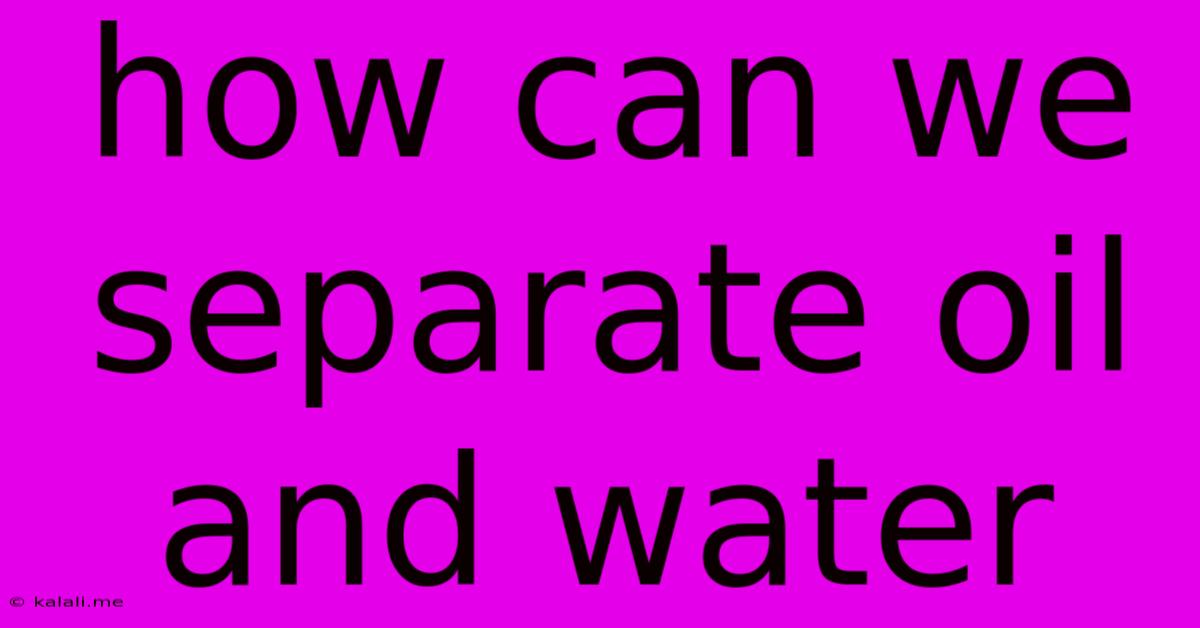How Can We Separate Oil And Water
Kalali
May 20, 2025 · 3 min read

Table of Contents
How Can We Separate Oil and Water? A Comprehensive Guide
Oil and water, famously known for their immiscibility, present a fascinating challenge in separation. Understanding the properties that cause this incompatibility is key to mastering the techniques used to separate them. This article explores several methods, from simple household techniques to more sophisticated industrial processes, explaining the science behind each.
This guide will cover various techniques used to separate oil and water mixtures, including decantation, using a separating funnel, centrifugation, and filtration, alongside explaining the underlying principles of density and polarity. We'll also touch upon the importance of these separation methods in various industries and environmental contexts.
Understanding the Immiscibility of Oil and Water
The inability of oil and water to mix stems from their differing molecular polarities. Water is a polar molecule, meaning it has a slightly positive and a slightly negative end. This allows water molecules to form strong hydrogen bonds with each other. Oil, on the other hand, is typically nonpolar, lacking this charge separation. This difference in polarity prevents the formation of strong attractive forces between oil and water molecules, leading to their separation into distinct layers. The density difference between oil and water further contributes to their layering, with oil, typically less dense, floating on top of the water.
Methods for Separating Oil and Water
Several methods can effectively separate oil and water mixtures, each suited to different scenarios and scales:
1. Decantation
This is the simplest method, ideal for small-scale separations where a clear boundary exists between the oil and water layers. It involves carefully pouring off the top layer (oil) leaving the bottom layer (water) behind. This method is effective when the oil and water are relatively still and undisturbed, minimizing mixing. However, complete separation is unlikely, with some oil remaining in the water.
2. Separating Funnel
A separating funnel is a laboratory apparatus designed for separating immiscible liquids. The mixture is poured into the funnel, allowed to settle, and then the stopcock at the bottom is carefully opened to drain the denser liquid (water). This method allows for more precise separation than decantation, minimizing contamination. It is commonly used in chemistry labs and small-scale industrial applications.
3. Centrifugation
Centrifugation employs a high-speed spinning motion to separate liquids of different densities. The centrifugal force pushes the denser liquid (water) to the outside, while the less dense liquid (oil) remains closer to the center. This method is particularly useful for separating emulsions, where oil and water are finely dispersed. Industrial applications of centrifugation are widespread in various oil processing and wastewater treatment plants.
4. Filtration
While not directly separating based on density or polarity, filtration can be a supplementary technique. If the mixture contains solid particles, filtration can remove them before employing other separation methods, improving the overall separation efficiency. Different filter types are used based on the particle size and the desired level of purity. This is particularly important in environmental remediation and oil spill cleanup.
5. Adsorption
Certain materials can selectively adsorb oil, leaving behind cleaner water. This technique, using materials like activated carbon or other absorbent substances, is employed in some advanced oil-water separation systems, typically on an industrial scale. This is an effective way to deal with oil contamination in water.
Applications of Oil-Water Separation Techniques
The separation of oil and water has numerous industrial and environmental applications, including:
- Oil refining: Various separation techniques are essential in the refining process to purify crude oil.
- Wastewater treatment: Separating oil from wastewater is crucial to protect the environment.
- Chemical industry: Many chemical processes involve separating oil and water mixtures.
- Environmental cleanup: Oil spills necessitate efficient oil-water separation for environmental remediation.
Conclusion
Separating oil and water is a critical process with wide-ranging applications. The choice of method depends on the scale of the operation, the properties of the mixture, and the desired level of separation purity. Understanding the fundamental principles of density and polarity, along with the various techniques described above, is crucial for efficient and effective oil-water separation in diverse settings.
Latest Posts
Latest Posts
-
Convert Three Phase To Single Phase
May 20, 2025
-
Login Failed For User Token Identified Principal
May 20, 2025
-
Difference Between A 2 Stroke And A 4 Stroke
May 20, 2025
-
How To Add Songs To Ipod Without Itunes
May 20, 2025
-
How Do You Get Silicone Off Glass
May 20, 2025
Related Post
Thank you for visiting our website which covers about How Can We Separate Oil And Water . We hope the information provided has been useful to you. Feel free to contact us if you have any questions or need further assistance. See you next time and don't miss to bookmark.